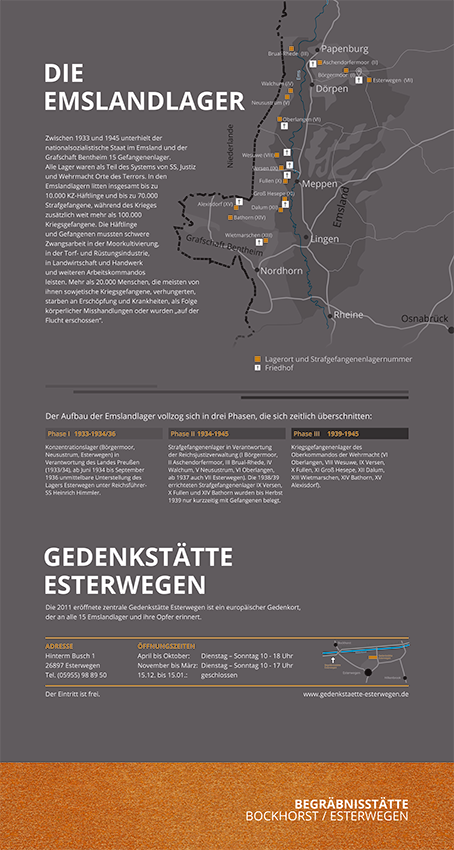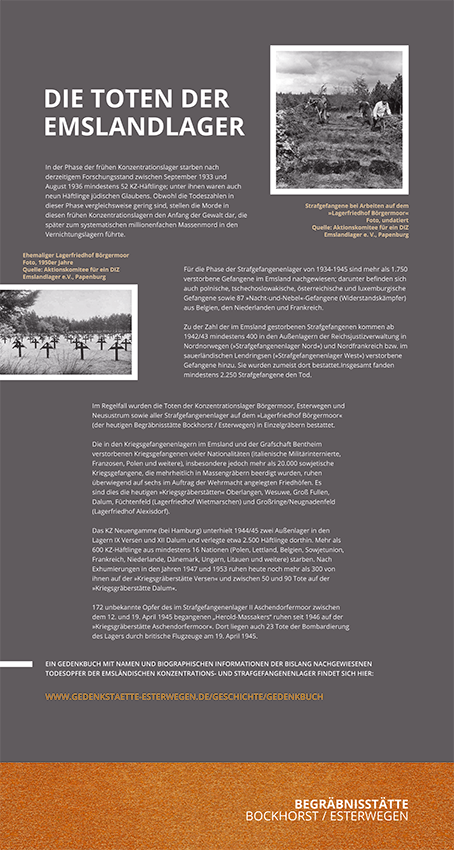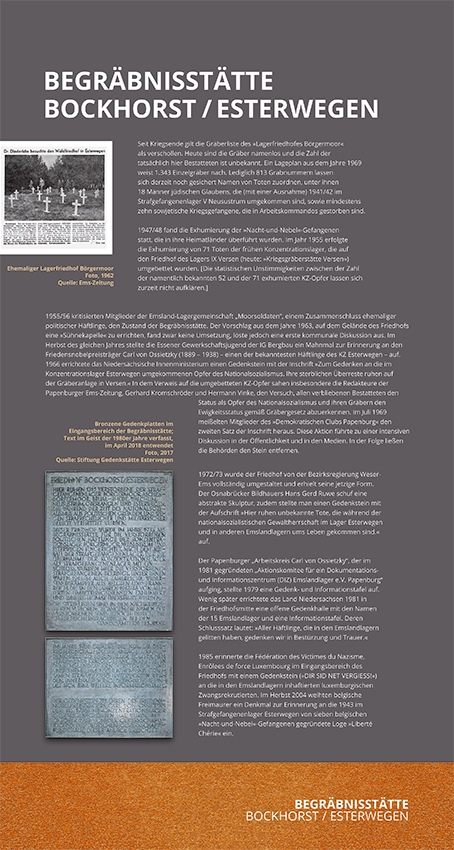BURIAL SITE ESTERWEGEN / BOCKHORST CEMETERY
Since the end of the war, the list of graves in the ‘Boergermoor camp cemetery’ has been considered lost. Today, the graves are nameless and the number of people actually buried here is unknown. A site plan from 1969 shows 1,343 individual graves. Only 813 grave numbers can still be reliably assigned to the names of the dead, including 18 men of Jewish faith who (with one exception) perished in 1941/42 in the prison camp V Neusustrum, as well as at least ten Soviet prisoners of war who died in labour detachments.
In 1947/48, the ‘Nacht-und-Nebel’ (Night-and-Fog) prisoners were exhumed and transferred to their home countries. In 1955, 71 dead from the early concentration camps were exhumed and reburied in the cemetery of Camp IX Versen (today: ‘Versen War Cemetery’). [The statistical discrepancies between the number of 52 known names and the 71 exhumed concentration camp victims cannot be clarified at present].
In 1955/56, members of the Emsland camp community ‘Moorsoldaten’, an association of former political prisoners, criticised the condition of the burial site. The proposal in 1963 to build a ‘chapel of atonement’ on the site of the cemetery was not realised, but did trigger the first communal discussion. In the autumn of the same year, the Essen trade union youth of IG Bergbau erected a memorial in memory of the Nobel Peace Prize winner Carl von Ossietzky (1889 - 1938) - one of the most famous prisoners of the Esterwegen concentration camp.
In 1966, the Ministry of the Interior of Lower Saxony erected a memorial stone with the inscription ‘In memory of the victims of National Socialism who perished in the Esterwegen concentration camp. Their mortal remains rest in the cemetery in Versen.’ The editors of the Papenburger Ems-Zeitung, Gerhard Kromschröder and Hermann Vinke in particular, saw the reference to the reburied concentration camp victims as an attempt to deny all the remaining buried victims the status of victims of National Socialism and their graves the eternal status in accordance with the Graves Act. In July 1969, members of the ‘Democratic Club Papenburg’ chiselled out the second sentence of the inscription. This action led to an intensive discussion in public and in the media. As a result, the authorities had the stone removed.
In 1972/73, the cemetery was completely remodelled by the Weser-Ems district government and was given its current shape. The Osnabrück sculptor Hans Gerd Ruwe created an abstract sculpture and a memorial stone was erected with the inscription ‘Here rest unknown dead who perished during the National Socialist tyranny in the Esterwegen camp and other Emsland camps’.
The Papenburg ‘Carl von Ossietzky Working Group’, which became the ‘Action Committee for a Documentation and Information Centre (DIZ) Emslandlager e.V. Papenburg’ founded in 1981, erected a memorial and information plaque in 1979. A little later, in 1981, the state of Lower Saxony erected an open memorial hall with the names of the 15 Emsland camps and an information plaque in the centre of the cemetery. Its final sentence reads: ‘We commemorate all prisoners who suffered in the Emsland camps in dismay and mourning.’
In 1985, the Fédération des Victimes du Nazisme, Enrôlees de force Luxembourg commemorated the Luxembourgish forced labourers imprisoned in the Emsland camps with a memorial stone (‘DIR SID NET VERGIESS!’) at the entrance to the cemetery. In autumn 2004, Belgian freemasons dedicated a monument in memory of the ‘Liberté Chérie’ lodge founded in 1943 in the Esterwegen prison camp by seven Belgian ‘Night and Fog’ prisoners.
Short guided tours:
Every 1st Sunday of the month, at 11am and 3pm. Please contact us in advance for a tour in English.







